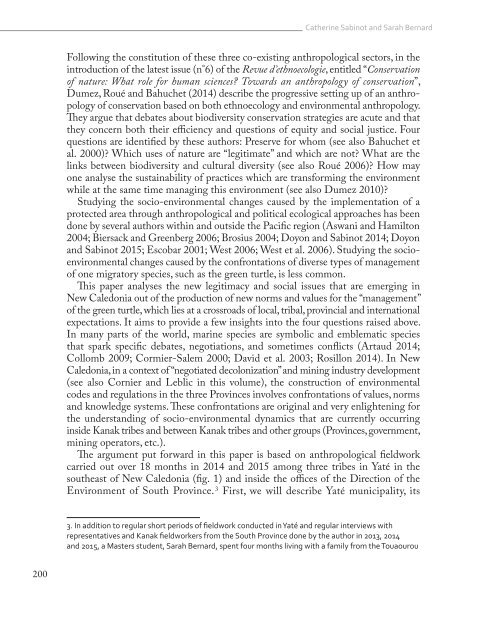Fisheries in the Pacific
Fisheries_in_the_Pacific
Fisheries_in_the_Pacific
Create successful ePaper yourself
Turn your PDF publications into a flip-book with our unique Google optimized e-Paper software.
Ca<strong>the</strong>r<strong>in</strong>e Sab<strong>in</strong>ot and Sarah Bernard<br />
Follow<strong>in</strong>g <strong>the</strong> constitution of <strong>the</strong>se three co-exist<strong>in</strong>g anthropological sectors, <strong>in</strong> <strong>the</strong><br />
<strong>in</strong>troduction of <strong>the</strong> latest issue (n°6) of <strong>the</strong> Revue d’ethnoecologie, entitled “Conservation<br />
of nature: What role for human sciences? Towards an anthropology of conservation”,<br />
Dumez, Roué and Bahuchet (2014) describe <strong>the</strong> progressive sett<strong>in</strong>g up of an anthropology<br />
of conservation based on both ethnoecology and environmental anthropology.<br />
They argue that debates about biodiversity conservation strategies are acute and that<br />
<strong>the</strong>y concern both <strong>the</strong>ir efficiency and questions of equity and social justice. Four<br />
questions are identified by <strong>the</strong>se authors: Preserve for whom (see also Bahuchet et<br />
al. 2000)? Which uses of nature are “legitimate” and which are not? What are <strong>the</strong><br />
l<strong>in</strong>ks between biodiversity and cultural diversity (see also Roué 2006)? How may<br />
one analyse <strong>the</strong> susta<strong>in</strong>ability of practices which are transform<strong>in</strong>g <strong>the</strong> environment<br />
while at <strong>the</strong> same time manag<strong>in</strong>g this environment (see also Dumez 2010)?<br />
Study<strong>in</strong>g <strong>the</strong> socio-environmental changes caused by <strong>the</strong> implementation of a<br />
protected area through anthropological and political ecological approaches has been<br />
done by several authors with<strong>in</strong> and outside <strong>the</strong> <strong>Pacific</strong> region (Aswani and Hamilton<br />
2004; Biersack and Greenberg 2006; Brosius 2004; Doyon and Sab<strong>in</strong>ot 2014; Doyon<br />
and Sab<strong>in</strong>ot 2015; Escobar 2001; West 2006; West et al. 2006). Study<strong>in</strong>g <strong>the</strong> socioenvironmental<br />
changes caused by <strong>the</strong> confrontations of diverse types of management<br />
of one migratory species, such as <strong>the</strong> green turtle, is less common.<br />
This paper analyses <strong>the</strong> new legitimacy and social issues that are emerg<strong>in</strong>g <strong>in</strong><br />
New Caledonia out of <strong>the</strong> production of new norms and values for <strong>the</strong> “management”<br />
of <strong>the</strong> green turtle, which lies at a crossroads of local, tribal, prov<strong>in</strong>cial and <strong>in</strong>ternational<br />
expectations. It aims to provide a few <strong>in</strong>sights <strong>in</strong>to <strong>the</strong> four questions raised above.<br />
In many parts of <strong>the</strong> world, mar<strong>in</strong>e species are symbolic and emblematic species<br />
that spark specific debates, negotiations, and sometimes conflicts (Artaud 2014;<br />
Collomb 2009; Cormier-Salem 2000; David et al. 2003; Rosillon 2014). In New<br />
Caledonia, <strong>in</strong> a context of “negotiated decolonization” and m<strong>in</strong><strong>in</strong>g <strong>in</strong>dustry development<br />
(see also Cornier and Leblic <strong>in</strong> this volume), <strong>the</strong> construction of environmental<br />
codes and regulations <strong>in</strong> <strong>the</strong> three Prov<strong>in</strong>ces <strong>in</strong>volves confrontations of values, norms<br />
and knowledge systems. These confrontations are orig<strong>in</strong>al and very enlighten<strong>in</strong>g for<br />
<strong>the</strong> understand<strong>in</strong>g of socio-environmental dynamics that are currently occurr<strong>in</strong>g<br />
<strong>in</strong>side Kanak tribes and between Kanak tribes and o<strong>the</strong>r groups (Prov<strong>in</strong>ces, government,<br />
m<strong>in</strong><strong>in</strong>g operators, etc.).<br />
The argument put forward <strong>in</strong> this paper is based on anthropological fieldwork<br />
carried out over 18 months <strong>in</strong> 2014 and 2015 among three tribes <strong>in</strong> Yaté <strong>in</strong> <strong>the</strong><br />
sou<strong>the</strong>ast of New Caledonia (fig. 1) and <strong>in</strong>side <strong>the</strong> offices of <strong>the</strong> Direction of <strong>the</strong><br />
Environment of South Prov<strong>in</strong>ce. 3 First, we will describe Yaté municipality, its<br />
3. In addition to regular short periods of fieldwork conducted <strong>in</strong> Yaté and regular <strong>in</strong>terviews with<br />
representatives and Kanak fieldworkers from <strong>the</strong> South Prov<strong>in</strong>ce done by <strong>the</strong> author <strong>in</strong> 2013, 2014<br />
and 2015, a Masters student, Sarah Bernard, spent four months liv<strong>in</strong>g with a family from <strong>the</strong> Touaourou<br />
200


